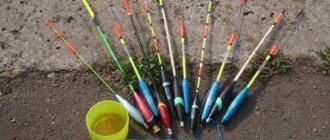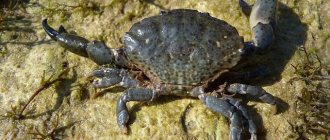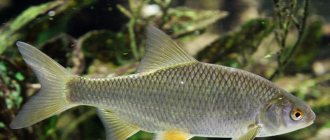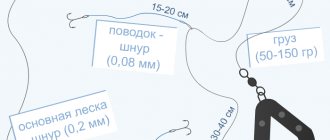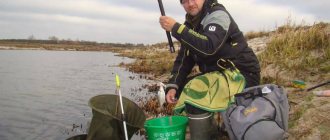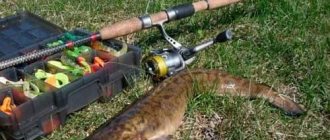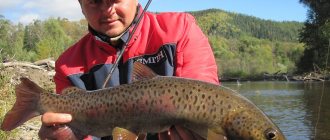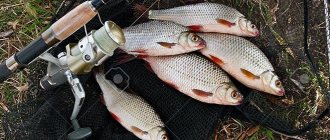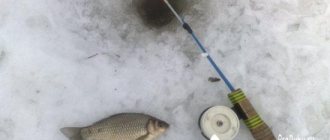116
We recommend viewing
It's a sad time! Ouch charm! - this is what the great Russian poet once wrote. Indeed, golden autumn is the most beautiful time of the year. There is probably no such riot of colors even in May. But I absolutely cannot agree that this time can be sad. The weather in mid-autumn is magnificent, and the fish caught is very diverse. Things are especially good now with predator catching. Perch, pike and pike perch are excellently caught using spinning rods and live bait tackle. And with a feeder, if you try, you can do some good fishing. While the water has not yet completely cooled down, there is a high probability of catching bluegills, breams and even crucian carp.
However, now I want to tell you about a completely different fishing experience. I have been sick with it for more than 40 years. And every year, as soon as the tops of the maples begin to turn yellow, I put off all my work and always devote several days to catching autumn roach with a float rod.
The roach is a notorious coward, and even in summer she is very distrustful of everything that makes her suspicious. For example, a roach will never accept bait, the color of which is very different from the color of the bottom of the reservoir. The same can be said about the structure of the gear. Roach and rough tackle are incompatible concepts. A little miscalculation with the correct animation of the bait, and you might not even get a bite. In cold autumn water, a roach's sense of self-preservation doubles or even triples. And this must be taken into account.
Rod
To catch autumn roach, it is enough to get a 5-7 meter rod. Most often I use the 7-meter Team Salmo TOURNAMENT POLE, and the 6-meter Team Salmo POLE.
Both rods are very light and have a fast action. With a rod in which only the tip bends when casting, it is very easy to control equipment whose weight ranges from 2-4 grams.
If the main line is made half a meter shorter than the rod, then even with a strong side wind the presentation of the bait turns out to be almost like that of a plug. The bait on the hook can be held much slower than the current, or even stopped at the point you need. With a softer rod, you are unlikely to succeed in such a “trick”.
I use a short rod in cases where there is not much pressure from anglers on the shore, and the fish can be pulled to the shore with bait. A long rod comes in handy in cases where the shore is noisy, and in order to see the bite, you need to cast the tackle a little further than your neighbors. It is advisable that the rod for catching roach be equipped with a flexible monolithic whip of the “whalebone” type. Having a flexible tip allows me to work with the thinnest leaders, which in cold water significantly increases the chances of success.
What to use to catch crucian carp in the fall on a float
Crucian carp is an almost omnivorous fish. Of course, you can’t catch this fish with live bait, but it’s quite difficult to list all the variety of plant and animal baits for catching crucian carp. Crucian carp are mainly caught using the following baits:
- worm;
- bloodworm;
- maggot;
dough;- semolina;
- corn;
- peas;
- bread;
- semolina;
- pearl barley;
- bark beetle;
- May beetle larva;
- burdock moth larva;
- dragonfly larva, etc.
As you can see, the list is not small and it is far from complete. But you should take into account that crucian carp needs protein in the fall, and it is present in animal bait, so in the fall you should catch crucian carp using:
- worm;
- bloodworm;
- maggots and other animal baits.
You won’t get any crucian bites with plant baits at all, or they will be very rare. Now he is not at all interested in them, because his body requires animal protein, which is rich in energy, which the crucian carp needs to stock up on for the whole winter.
Bait in the fall for crucian carp in the fall is no longer so effective and it is only relevant to use it in September. And later, the crucian carp already occupies certain areas and it is difficult to lure it out of there even with the most aromatic bait. But still, I always prefer to use bait, if not to attract fish, then at least to stimulate its bite. If you manage to find a hole in which the crucian carp is supposed to stand, then the bait with its aroma will whet its appetite and the bites will be more frequent and bold. Find out how to prepare bait for crucian carp in this article.
That’s basically all that could be said about autumn crucian carp fishing. I think I managed to explain all the most useful information in the article and this information will be useful to you. And finally, as usual, an interesting video on the topic.
fishing line
As the main fishing line for catching autumn roach, I most often use the Team fishing line
Salmo Fluorocarbon thickness 0.16-0.18 mm. How is it an unusual choice? Agree. But I use this line not because it is invisible in the water (although this factor also contributes to the fact that in clear water the fish are less afraid of the equipment), but because it is stiffer compared to other monofilament lines. In windy weather, a stiff line makes fishing more comfortable.
But I intentionally make leashes from soft Team Salmo TOURNAMENT NYLON fishing line with a diameter of 0.1 mm. It’s not scary that the strength of nylon fishing lines is slightly lower than their nylon counterparts (0.81 kg versus 1.09 kg) - for catching wary autumn fish, their amazing softness is much more important.
Equipment
To make the bait on the hook look more believable to the fish, I only use a multi-point float loading scheme. For floats with a carrying capacity of up to 2 grams, this is a chain of pellets of decreasing mass. I load heavier floats, weighing 2.5-4 g, with one massive olive sinker, which contains up to 70% of the total mass of the equipment, and a chain of pellets of decreasing weight. Using a heavy weight makes my rigs less prone to overlapping. In addition, with a massive sinker, the bait on the hook reaches the working horizon faster. The leash must be short, 10-15 cm long. I traditionally select the hook size to match the size of the bait.
Most often, my rigs are equipped with hooks No. 14-16 made of thin wire.
Floats
The choice of float models in our time is large, but in order to tempt the cautious autumn roach to bite, you need to be very careful when choosing this accessory.
A modern float is more than a bite alarm. The presentation of the nozzle greatly depends on its choice. In calm weather, which is very rare in the fall, I use spindle-shaped floats. Such floats have amazing sensitivity. But in the wind, when there is a fairly strong wind current in the reservoir, the most popular models are floats with a low center of gravity. If such a float is loaded to the base of the antenna, the ring for passing the fishing line is 5-7 cm below the water level. Together with the ring, part of the main line is under water, and the drift of the entire equipment is significantly reduced. A float for catching autumn roach must have a thin antenna that is clearly visible on the surface of the water. And in order to see even the most careful bite, I use floats with antennas no more than 2 mm thick.
Catching bream in September with a float rod
Where to catch bream in September
At the beginning of the month, bream continue to swim among aquatic vegetation, where insect larvae and small crustaceans can still be found. The peak of the bite is 10-11 am. Towards evening, the bite begins to subside, although there are days when bream bite well not only at sunset, but also in complete darkness. Large individuals prefer to stay apart from their smaller brethren, obtaining food for themselves in splendid isolation, fearing competition from more nosy small brethren. Towards the end of the month, when the water begins to steadily cool, bream gather in large schools and go in search of wintering holes. The last ten days of September coincide with the beginning of the autumn zhora. The bream begins to eat everything that comes in its way. He does not hesitate to feast on the fry.
You should look for bream in September in the following places:
- among snags;
- in places of steep cliffs;
- close to reeds and sedges;
- in river pools;
- in sections of the river with reverse flow;
- among the thickets of aquatic vegetation that has not yet had time to fall to the bottom.
You should not look for bream in places where the bottom is covered with mud. It prefers silty or clayey areas, where a variety of benthic life is found in abundance. You can detect a school of bream by a series of bubbles rising to the surface of the water where the fish rummages through the mud, trying to find something edible in it.
In September it is still advisable to use bait. It is difficult to overfeed a hungry bream, so there should be a lot of bait. To keep a flock in one place, it is not enough just to create a feeding turbidity. Something more substantial is needed - large particles that the bream will slowly absorb. Pearl barley, corn, cereals, steamed peas, etc. are suitable for this purpose. You should not experiment with odors, most of which can only scare the fish away from the fishing spot.
Advice! At the beginning of the month, bream will be attracted to the faint aromas of hemp and anise. If you are fishing from a boat on a river, then the bait should be scattered above the float so that the bait is in the cloud of turbidity. If on the lake, then in close proximity to the gear.
What to use to catch bream in September
Bait and bait for bream in September:
- worms (dung worms, earthworms, crawling worms);
- barley flavored with sunflower oil;
- bloodworm;
- maggot;
- mastyrka;
- semolina mash;
- peas;
- bread crumb;
- dough.
Are you sitting correctly?
Trying to catch autumn roach standing at the very edge of the water is a waste of time. Most often, the prey of such an angler are roaches the size of an index finger. It's all about the natural caution of this fish, which sees the silhouette of a person and is afraid to come close to the shore.
If you fish from a sitting position, and even move a meter and a half away from the water’s edge, the fishing result will be much better. If you follow the basic rules of camouflage, even large roaches can be pulled with bait to the first edge, where the depth does not exceed 1.5-2 meters. Of course, carrying a chair around while fishing is not very convenient, but a backpack with a built-in folding stool turns out to be a very good solution.
In addition to the necessary camouflage, this accessory relieves the load on the legs and allows you to have the necessary minimum of additional equipment on hand.
Feeding
For roach fishing, the correct bait is no less important than the correct gear. Many anglers ignore this rule and lose. In my understanding, bait for catching autumn roach must be dark, finely dispersed, and moderately active. Excessive aromatization of roach baits is more likely to cause harm. You can also use highly flavored baits left over from the summer, just sift them through a fine sieve several times and dilute them heavily with dark earth - the share of earth in my roach baits reaches 50-70%.
Of the imported dry mixtures, I most often use Sensas 3000 Super BLACK Canal, and of the domestic ones, Vabik, Black Roach.
To save precious fishing time, I do all the operations of soaking the dry mixture and adding earth to it at home. In a few hours, the bait has time to be properly saturated with water, and does not generate so much dust in the water. On the shore, all I have to do is add a live component to the bait and start fishing. The live ingredients I most often use are casters and dead maggots. Bloodworms are used less often, and chopped worms are almost never used. For some reason, in the fall, fish do not react to worms.
The most common tactics for feeding autumn roach are as follows. After determining the fishing point, I throw 2-3 tightly molded balls of bait the size of an apple into the water and start catching fish.
Even if there are no bites during the first half hour of fishing, I do not provide additional feeding. In the fall, it is very important to maintain the correct fishing pace, and untimely supplementary feeding can ruin fishing for a long time. Even after the fish starts feeding and regular bites begin, more often than at intervals: 15 minutes - the fish, I do not feed it. And then I use small balls of bait for this, the size of plums.
Features of autumn fishing on rivers
The warm summer has come to an end. Beauty - autumn decorated the forests in all the colors of the rainbow, with a generous hand scattered mushrooms throughout the forests and copses, and hung drops of dew with pearl threads on the ubiquitous web. Significant changes occur in the behavior of all living organisms associated with the restructuring of the body for winter. This applies primarily to Pisces.
Starting from mid-August, the water temperature begins to drop. This is due, first of all, to a decrease in daylight hours and an increase in the length of night. Mornings, often as cold as September, cool the water faster and faster. By the end of August, the water temperature in the rivers does not exceed 15 degrees and becomes clear, like a tear. It is these factors that influence the behavior of fish. She begins to gather in large flocks and feed intensively before winter. And the purification of the water makes fishing in relatively shallow areas devoid of shelter practically ineffective - shallow runs, shallows, shallow sand spits - the fish tries to leave such places as quickly as possible, since it feels unprotected in them.
If you frequently visit the same river in the fall, you will notice significant fish migrations. On large rivers they appear less noticeably, on small rivers - more. For small rivers, there are certain main wintering places where the fish migrate. As a rule, there are no wintering pits on them, and it rolls either into larger rivers or into various lakes connected by small channels with small rivers. As an example, I can give one small river. A small stream flowing from a large bream lake flows into it. The river itself flows into another, larger river. Fish migrations are clearly visible when, from the end of August, fish gathered in large schools begin their journey to the lower reaches, to their wintering grounds. She overcomes several hundred meters per day. While fishing in those areas every weekend, I noticed the following trend. Today, for example, fish - roach, chub, bream and silver bream - can be caught well in one hole. The next weekend - this place is empty, only small bleaks. And the main school of fish is 3-4 kilometers downstream! You literally have to chase the fish to find and catch it. And then, when the fish reaches the mouth of the flowing stream, white bream and silver bream suddenly disappear from the catch. There are noticeably fewer roaches, only chubs still delight with their bites. That is, the distribution is obvious - undergrowth, silver bream and part of the roach rise up the stream into the lake for the winter, and the rest of the fish rolls into the big river. In the spring, in April-May, exactly the same picture is observed, but exactly the opposite.
There are also situations that are radically different from those described above. I have one secret place where the small river Svisloch flows into the Berezina. For several kilometers from the confluence in both directions on the Berezina there are no good depths - only fishless meter-long runs. On the Svisloch, on the contrary, at the mouth there is a cascade of good holes - 3-4 meters deep. And for some reason, at the end of October, fish (large roach, dace and chub) go to this small river for the winter. On the Berezina you won’t see a bite at this time, but on the Svisloch you can catch excellent roach and dace from November until spring, and during the period of prolonged thaws, when the river is cleared of ice, even in winter. As soon as the first streams run and the spring sun warms up, the fish leave the river for the vastness of the Berezina. But such cases are exceptions to the rules, knowing which you can count on good catches even in November-December. All of the above is also true for the rivers of central Russia.
Starting from the end of August - September, the summer hot spots become empty, and the fish strive to occupy their local wintering places. She refuses to leave them, and no amount of food can get her through. The exception is night bream fishing. When fishing on large rivers, where the water is very clear by September, it has been noticed that bream very often comes out to feed at night. With the onset of dawn, it rolls back into the pits and stops feeding. Excellent bream catches were produced by shallow runs of 3-4 meters at the exits of the pits. During the day, these places are empty, only occasionally small fish touch the bait. But this pattern must be checked, because it does not always and not always work. On some rivers, night fishing is practically useless - the bite subsides with the onset of dusk and resumes only at dawn. Rare isolated bites in the middle of the night can be attributed to errors; there is no stable and distinct bite. On others, it’s quite the opposite: during the day, small fish touch the bait, and even then reluctantly. At the same time, at night, large bream and silver bream come out to feed in the same places, and you can catch the norm in just a couple of hours...
When fishing on rivers at the end of summer - in the fall, you need to choose fairly deep places - holes, backwaters, deep-water bays. If wintering pits are known, runs at the entrance and exit to them will be good. As a rule, summer fishing spots do not work; as the water clears and gets colder, the fish leave there.
As for fishing tactics, it is impossible to give any specific advice for all occasions for autumn fishing. The fish becomes capricious and cautious, and it is much more difficult to find the key to it. If you know good places to which the fish migrate, you can try to feed and watch its exit. But such places are well known to many fishermen. Often in such places, fishing takes place on a “shift” basis - some left and others arrived. It is not possible to get to such places. If such places are unknown, search, search and search again. The feeder turns into a running donk, no bulk feeding and waiting - there may simply be no fish at the fishing site! In this situation, it is much easier to find an active fish that is determined to feed, rather than trying to force a passive fish to eat the bait.
Bait for river autumn fishing should be heavy, inert, coarse-grained. Due to the clearing of the water, it should be darkened almost always - a bright spot on a dark background scares away large and cautious fish. Large components (porridges, cereals), which have proven themselves in the summer, should be added with caution. Just like aromatics - overly aromatized, brightly smelling bait will scare away the fish faster than attract it. It has been noticed that mild scents (coriander, anise, cinnamon) work better on bream than traditional summer sweet scents (vanilla, caramel, etc.).
However, there are two diametrically opposed opinions regarding aromatics. One part of fishermen adheres to the classical point of view - the colder the water, the more passive the fish and the weaker it reacts to odors. Accordingly, odors should be minimal, otherwise there is a high chance of simply scaring away the fish.
Another part of the fishermen, referring to the simplest laws of chemistry, interprets their arguments as follows. In cold water, the diffusion process slows down, and for fish to smell the same smell, it must be many times stronger than in summer. Accordingly, the doses of aromatics should be super strong. As for the passivity of the fish, up to a temperature of 10 degrees the fish feed quite actively.
Which of these points of view is closer to the truth can only be shown by practice. In any case, both points of view have the right to life, and in one fishing trip you can test both. My last fishing trips did not show any significant advantage of super-aromatic bait compared to regular bait. However, there are very few developments, and experiments in this area will continue.
The best way to attract and keep fish at a point in the autumn is an animal component - bloodworms, maggots, cut worms. Moreover, it is better to add it not to the entire volume of bait, but in portions, to the feeder. In this way, you can control the fish’s interest in adding an animal component – whether it activates the fish or not, whether it affects the bite. In general, complete improvisation and creative freedom :)
As for baits and attachments for fishing, it is believed that in cold water the favorites are animal food - bloodworms, maggots, worms. Personally, in my conditions, bloodworms work not only in cold water, they attract fish better than maggots from the July heat. It also works great in cold water in September-October. However, do not forget about the traditional baits - corn, pearl barley and peas. Coupled with baiting and adding corn and peas to bait, they perfectly attract chub and ide - friends catch chubs with corn, even from ice using winter fishing rods. Pearl barley attracts large roach and dace.
As for fishing gear, the main ones in the autumn will be a feeder and a lapdog. Depending on the fishing location, the equipment is also selected - the weight of sinkers, feeders, floats, feeder tests - everything is selected individually, depending on the specific fishing location, the bait used and the planned fish. There are no significant differences from summer fishing.
When going to the autumn river in September - October, you should not forget that during this period the fishing place is primary. Catching river fish in the fall is quite difficult in itself, requiring patience and perseverance. The time is not far off when it will begin to snow, and the snow will begin to swirl, and your favorite gear will have to be put aside until spring. Well, while you still have the opportunity, go to the river. Behind the impressions, behind the painful, sad emotions that fading nature evokes. After all, this is an integral part of fishing... As it was sung in one song - “I’m not going for fish, I’m going fishing...”
Nozzles
The principle: what we feed is what we catch, it works very well for roach. If I use casters and maggots for bait, then I mainly fish with them.
Sometimes fish respond better to brown bread dough or toast granules. Then, as bait, I use black bread mixed with soil, or bread crumbs rubbed through a sieve.
Autumn lures
Autumn bream also reacts to bait in a special way. The main one is bloodworms, but if in the summer it takes well on a bunch (as much as will fit on the hook), then in the autumn it can sometimes be reluctant to react even to two or three small bloodworms, and will swallow one with great pleasure. Although it is important to take a variety of baits with you in the fall, it is often a loser to go with one bloodworm. In addition to bloodworms, both a worm and maggots can work great, and not the usual white one, but a colored one. Nowadays the assortment of maggots in fishing stores is huge - blue, yellow, green, white, red... And bream appreciates this - maybe they don’t take the white one at all, but just give it the red one. It happens that in the fall large specimens prefer a “traffic light” - a sandwich of multi-colored maggots. At times, bloodworms work well together with maggots. As usual, these important details are calculated purely experimentally.
Fishing tactics
In autumn, the fish becomes inert, and is unlikely to chase even the most delicious bait if it swims half a meter from the feeding point, or its speed is greater than the current. Therefore, it is very important to learn how to slow down the equipment. This is where a stiff rod and short line come in handy. Having lowered the tip of the rod to the water itself, I constantly slow down the equipment, forcing the bait on the hook to slowly move at the very bottom.
As you can see, there is nothing difficult in catching autumn roach. So don’t waste time, and while it’s still warm, go with a float rod for autumn roach. I'm sure you won't regret it.
